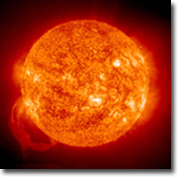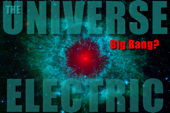
home • thunderblogs • forum • picture of the day • resources • team • updates • contact us
Dark Inertia - Part Two02/24/08 The Nature of "Expansion" Included in the growing list of untenable theories tossed in the Big Bang quilt is the concept of "dark energy". It is assumed that the universe is not only expanding but that this supposed expansion is accelerating.
It is claimed that when General Relativity is applied the result is a universe that either infinitely expands or contracts back towards the mathematical "singularity" from which it sprang. To coral this problem and stay in line with the prevailing notions of the day Einstein conjured a "cosmological constant" to keep the universe from doing either (static). Later, Edwin Hubble's expansive interpretation of redshift brought about the assumption that galaxies were receding away from us and each other. This caused Einstein to reject his earlier invocation calling it his "greatest blunder". Things become even more unusual. Not only is empty space given an expansive quality but it also "warps" and "curves" around celestial objects. The assumed recession of galaxies away from us is not because galaxies are expanding into space but because space itself is expanding into...? - and carrying all matter and galaxies with it. Thus, the Hubble constant, a rate of expansion, is needed to explain how far space is moving over a given time unit. This would supposedly allow the theoretical big bang to be reversed and an age of the universe to be calculated. Thus goes the universe according to the standard model and it's "runaway acceleration" based on a flawed redshift assumption and the invocation of negative pressure via "dark energy". Eventually, stars will have spent their supposed thermonuclear fuel and the universe will grow cold and dark. The "Big Chill". Or. The tide will turn and gravity will reclaim it's overrated domain and crush everything in a "Big Crunch". Both scenarios present a bleak future to an unobservable time billions of years into the future. Perhaps the "greatest blunder" is assuming that the universe had a beginning, or will have an end, in the first place.
Another option: Induced Magnetic Repulsion
In 1956 plasma physicist Winston H. Bostick used actual plasmoids via a makeshift "plasma gun" and achieved characteristics remarkably like that of spiral galaxies as seen in the photo above. The photo is the first in a sequence of 6 from one of the actual lab experiments featured in Ohio's Lima News. Several such experiments were conducted and subsequently supported by computer simulation.
In an electric circuit 'induction' is a change in the state of a body or system as the result of a field. It is the linkage that can cause current flow, current density and electromagnetic fields to increase or decrease between neighboring systems and therefore alter their dynamic. When considered in relation to galaxies and galaxy clusters the electrical property of induction poses a different outlook to the concept of "expansion". Bostick was able to determine that the conversion of gravitational energy from compressed plasma into "mutually induced magnetic repulsions" could account for the observed expansion of the universe. Magnetism is a property of electrical activity and galaxies have magnetic fields invigorated by Birkeland currents. Therefore the concept of 'expansion' is not that as assumed by mainstream astrophysics, but moreso the repulsive movement of galaxies and celestial formations via [electro]magnetic induction. Depending upon the intensity of the Birkeland currents invigorating each galaxy, and the resulting magnetic field, both attraction and repulsion can occur at these scales. Professor Don Scott's book The Electric Sky cites an interesting observation. If you have an electric current flowing through two parallel conductors in close proximity to one another their respective magnetic fields will overlap. As one considers the overall view of the two electromagnetic fields surrounding those wires, the further away you get the more the two magnetic fields act as one 'system' and become indistinguishable as individual fields. The same would undoubtedly occur on lager scales with interacting galaxies and could be expanded to include galaxy clusters. A very simple analogy may allude to the properties discussed above. In a YouTube video entitled Searl and Newton Part 1. At 1:39 seconds into the video John Searl places a series of stacked disk magnets called a "roller set" onto his device. Observe what the "roller sets" do as they are placed. As he states the "rollers" repel each other and seek a position of equilibrium within the 'troughs'. Each new roller set added "disturbs" the distribution of the 'troughs' and a new distribution is dynamically updated. The "troughs" of which he speaks are the [electro]magnetic equivalent of gravitational Lagrange Points aka "saddle points". They are areas of minimal magnetic influence between existing systems. Expanding this analogy to planets, stars, galaxies, and galaxy clusters, supposed "collisions" become inappropriate and dynamic interactions of electric plasma formations become the order of the day. An example of this is the separation or repulsion via increases in the mutual strength of respective magnetic fields as used today in a "pneumatic sheet fanner". This is the same magnetic repulsion sensed when pushing like poles of magnets together but on a much smaller scale. Not only could he account for observed expansion of the universe ... without recourse to the Big Bang hypothesis, Bostick also concluded this repulsive activity is "...greater than the gravitational attractive forces between the galaxies" which demonstrates the 1039 orders of magnitude greater influence of electrical forces over gravity.
The interpretation of redshift as being the result of space itself 'expanding' and all matter being carried along for the ride like so many raisins in a rising batter is untenable. That same assumption is then cantilevered with additional conjecture which posits that reversing the assumed 'expansion' infers that everything was once together at a single point. An alternative view as put forth by Tift and Cocke as well as Halton Arp shows that the quantization of redshift in discernable steps means that it cannot equate with velocity. Thus, the "expansion" of space could not exist. Galaxies and galaxy clusters move and interact. The universe being 99.999% in the plasma state, those motions then become primarily susceptible to electromagnetism. The interrelated hierarchical nature of electric plasma dynamics may account for celestial motions via the electromotive force, without the need for an "expansion".
Permalink to this article.
Public comment may be made on this article on the
|

Solar is a regular contributor to the Thunderbolts Forum and a keen amateur astronomer. My Archives Chronological Archives Archives by Author Archives by Subject Thunderblogs home
|
|||||||||||||||||||||||||||||||||||||||||||||||||||||||||||
the material, and do not necessarily reflect the views of the Thunderbolts Project.
The linking to material off-site in no way endorses such material and the Thunderbolts
Project has no control of nor takes any responsibility for any content on linked sites.
home • thunderblogs • forum • picture of the day • resources • team • updates • contact us



